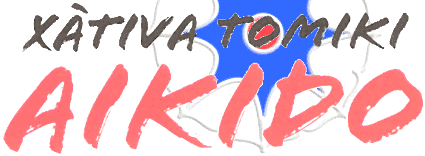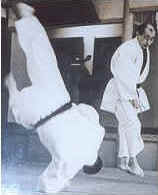|









VALENCIA TOMIKI AIKIDO




|
Website updated
04 Feb 2018
|
| |
| WINTER - STUDY GROUP SEMINAR - 2014 |
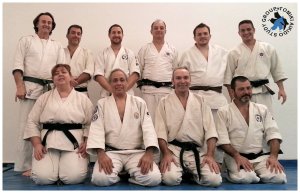 |
STUDY GROUP REPORT Friday 31st January 2014 – by Vicente Bosch
We started the session with some Basic Aikido exercises; the intention of these complimentary exercises is to rewire your body movement to avoid usage of isolated muscle during any time of practice thus improving your Aikido as a whole. As Adrian Tyndale Sensei lead the practice there was a focus change on some of the exercises.
|
Exercises as Techniques are not fixed, we must understand what we are doing and what we want to get out of them and adapt them accordingly but still adhering to the underlying principles of our Martial Art. In this run Adrian focused a bit on isolated shoulder movement (without raising) contraction and relaxation of the muscle before starting with the full exercises (sumo pushing, pulling rope) so that we would also think of this muscle. For diagonal pull and diagonal push he focused on the leg and pelvis part, we must first sit on the leg side in the direction of the exercise, then contract or expand the abdominal region accordingly.
These exercises are an important part of our practice and we refer to them when explaining movements inside other more complicated solo or paired exercises and Waza. Furthermore if you do them with certain concentration and intensity you get a nice warm up (as a side benefit, not a main one).
After these exercises we started with the main topic of this study group session: Koryu No Kata Dai
Ichi. One of the main objectives is to first learn the choreography of the kata and afterwards fill it up with contents (depending on each ones level). Adrian and Michael performed an initial run of the whole kata so the rest of us could get a feel for it. The kata is composed of 24 techniques, or as Adrian likes to put it, 4 sections: it just sounds shorter that way. The first day we concentrated on the
Suwari-Waza section. An initial remark of the correct distance for Suwari Waza was made: the adequate distance should be so that Uke can perform an attack on Tori with a simple small knee
Tsugi-ashi step. It is not an exact measure.
Kneeling
1 Oshi-taoshi
2 Tentai oshi-taoshi
3 Tekubi-osae
4 Ryote-dori sumi-otoshi
5 Ryote-dori koho-nage
1. Oshi-taoshi - The Waza starts when Tori performs a small movement to tempt Uke into the strike. As Uke rises to load the arm for the Shomen uchi strike Tori must raise with him and control his arm as it reaches the highest point (early). It is important to note that the main arm doing the control on Uke's attack is the left arm that hooks onto Uke's elbow; the right arm is not as essential. We performed a standing exercise to learn this hooking movement. Uke would launch a Tsuki to Tori’s face and Tori would control the strike with the left arm and perform Aigamae or Gyakugamae ate. Once the attack is controlled we must not perform the projection pushing Uke away but keep him close to us by performing a circular motion. For the final control of Uke: Uke must have his arm at an angle above shoulder height, Toes must be active, the ankles should be close to each other so that the knees can push in each direction so that Uke’s arm is stretched, if Uke's arm is nicely stretched the final elbow pin on the floor will be effective.
2 Tentai oshi-taoshi - The Waza starts in the same fashion as does the control but this time there is resistance from Uke to the projection so Tori adapts to this resistance. It is important to note that Tori must move to the side of Uke , turns and is more or less by his side ( as if taking a picture ) as the circling projection is performed. For the ground control it is important that Uke's shoulder does not contact the floor, skilled Uke's when having a reference point can escape pins, Tori must cradle Uke's arm and turn his stomach towards Uke's head.
3 Tekubi-osae - The Waza starts with the same attack but in this case Tori is late for the control. Tori must set the arms for the control in mid air but he must Uke continue with the strike (as it is too late) (Uke must have real intention to strike). Tori swivels to the side (to the side by side picture scene) as he raises his arm and applies the projection, which is a spiraling action that goes from Tori's back knee to the arms through the stomach. Pressure points are just a gimmick and may or may not work so not much thought was given to it.
4 Ryote-dori sumi-otoshi - The Waza starts with Uke getting hold of both of Tori's wrist the grab should be neutral (but it may not be so) Tori must make his life easier by messing up the contact point for the grab so that it is to his advantage. During this technique it is most important to note that both arms must have a forward tension and the pushing and turning comes from whole body movement. Tori should not use local power to push and should also not use one arm to pull and another to push. There should be full control as Tori pins Uke to the ground.
5 Ryote-dori koho-nage - The Waza starts with Uke pinned in the ground from 4. Tori releases the pin but maintains the extension of his arms as he swivels back to his position, while he does this he must maintain contact with Uke and "help" him up. Once up right in seiza Uke stands up and as he does so the back projection is put into motion by use of the basic aikido movements. For 4 and 5 a basic standing up game was made so that Tori would practice keeping the extension and connection with Uke as he moved around, get Uke down and "help" him up.
After this initial study of the Suwari Waza section Adrian introduced the format of Ninin Dori. We reviewed the formal part of the practice and competition:
rei, positioning, changing, etc and made some initial comments of the problems that can arise while performing Ninin Dori: Forgetting the other Uke, Positioning yourself in between Uke’s, not fully applying techniques, etc.
More Saturday . . . .
|
|
STUDY GROUP REPORT Saturday 1st February 2014 – by Vicente Bosch
Today we continued with the choreography of Koryu Dai Ichi.
The inspiration is from Sensei Hideo Oba and Sensei Takeshi Inoue.
We noted that when Sensei Takeshi Inoue performed this sequence later he changed a technique.
|
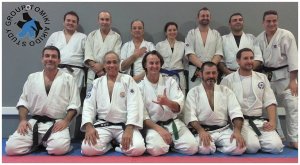 |
We started the session by playing the connection game used for techniques 4 and 5 of the Suwari Waza section. Tori would practice keeping the extension and connection with Uke as he moved around, got Uke down, helped him up ... it is very important to practice this extension and connection for our aikido and as it is a full body exercise you also get a nice warm up (as a side benefit).
For this second section we continued with the study of the Koryu no kata Dai-Ichi. Specifically we went through the first and second standing sections.
Standing 1
1 Oshi-taoshi
2 Tentai oshi-taoshi
3 Tenkai-kote-hineri
4.Kote-mawashi
5 Kote-gaeshi
6 Kote-gaeshi
7 Mae-otoshi
1 Oshi-taoshi - technique starts with Uke performing a crossed grab right hand to right hand. Initial Kuzushi can be performed a certain number of ways: turning the waist with rounded arms, stretching the stance (with a curve) , moving out (a more traditional way of doing things). After Tori performs this initial movement he sinks on his back leg to enhance the initial Kuzushi and make more space for him self and performs a circular motion up to Uke’s chest and pushing down (without local muscle) with the intention of controlling his tail bone. Once this control is made the left hand is put into action controlling Uke's elbow in a hook manner as we saw in the Suwari Waza techniques and raises Uke’s arm up to head height. Once it is there we make extend Uke (by means of his arm) in a oblique direction. The steps for extending or spreading Uke can be done in various ways they are all ok but we must make sure we always keep a good ground path as we do them (Yamada Sensei always preferred to do
Ayumi-Ashi rather than Tsugi-Ashi). Once on the ground, the hand control and leg change would occur, at this point Tori needs to sit back on his back leg and perform a circular motion against Uke's elbow to perform the pin.
2 Tentai Oshi-taoshi - technique starts with Uke performing a crossed grab left hand to left hand, the rest of the technique occurs in the same way up to raising the hand to Uke's head height, at this point Uke now shows some resistance to the direction of the projection seen in the first technique making Tori adapt. Tori adapts by stepping in to Uke's said and perform a circular motion that spirals out from Uke’s head to the back of Tori; Tori being the centre of the spiral. Tori must keep the spiral small otherwise we give Uke an opportunity to escape and the steps during the spiral are a set of compression and extension steps as we turn:
/ \ \ / / \
Once on the ground the rest of the pin is done in the same manner as Oshi-taoshi
3 Tenkai-kote-hineri - technique start by Uke grabbing Tori’s right hand wrist with his right hand and Tori's right hand elbow with his left hand. Tori performs the initial kuzushi in a very similar manner as with the last two techniques (with one of the valid methods) and once he has Uke on his side leg Tori grabs Uke's right arm wrist to perform the
Tenkai-kote-hineri. How much Tori steps in and the plane he turns around
(Tenkai) is up to Tori and his possibilities but the hineri-kuzushi must be observable all the during the technique from the point Tori grabs Uke's right hand wrist up to the point the pin is performed. For this pin on the floor we also observed to not allow Uke's shoulder to touch the floor in order to avoid Uke having a pivot point to counter the pin.
4 Kote-mawashi - technique start by Uke grabbing Tori's left hand wrist with his left hand and Tori's left hand elbow with his right hand. The kuzushi is performed with a left hand inside sweep, in order to do this correctly a waist turn must be performed (counter clockwise) in addition to this an Atemi with the right hand might or might not be performed. There is a "happy" coincidence with the right hand Atemi, as the right hand closes into Uke's head the waist turns as we want it to for the
kuzushi, maybe it was actually introduced just for this reason, maybe once this initial kuzushi is performed Tori's right hand crosses over to grab Uke's left to start the
kote-mawashi, if the initial kuzushi was done incorrectly Tori will loose his posture and lean over to his left side to perform the wrist grab, something clearly went wrong!! Perform kote-mawashi focusing on Uke's tailbone going down, release and perform the rest of the technique as with the first
oshi-taoshi.
5 Kote-gaeshi - technique starts by Uke grabbing Tori's right hand wrist with his right hand and his back collar with hist left hand (Tori must facilitate this). The kuzushi starts by Tori turning his waist against the grabbed side, here you might bob your head under Uke's arm or you might raise your right arm to release from the back collar grab, the waist turn action is done so that Tori's left hand gets a hold of Tori's right wrist setting up in this manner the Kote-gaeshi. One important thing when performing the Kote-gaeshi is that it a arm turn (with the elbow as a centre and the wrist as the action lever) and not a stretched out arm twist.
6 Kote-gaeshi technique starts by Uke grabbing Tori's left hand wrist with his left hand and his back collar with his right hand. As Uke goes for the back collar grab, Tori turns his waist and goes to grasp Uke's left hand, a turning action similar to the one in Tenkai kote hineri is performed without applying the lock which releases the back collar grab and the kote-gaeshi is performed.
7 Mae Otoshi - technique starts with Uke going for a right hand wrist grab and a lapel choke, Tori follows the motion by performing a gasho motion with his grabbed hand leaving Uke's armpit at the height of Tori's left arms elbow. Once in this position we can perform an Unsoku step or if more skilled a spiralling stretch from the right back leg up to the front to obtain the same effect without moving the feet.
Standing 2
1 Shiho-nage
2 Hiji-nage
3 Sukui-nage
4 Shiho-nage
5 Irimi-nage
6 Irimi-nage
For this second section focus was given on adequate footwork. This whole section is marked by an intelligent use of the kaiten movement (switching the direction of the stance), this movement can be performed many ways: on the balls of the feet, on the toes or in a two-step procedure.
The session was finished with a small Ninin dori test run this time around with some techniques being performed. During this test runs the practice was stopped to indicate some issues and give pointers as was seen fit.
More on Sunday.
|
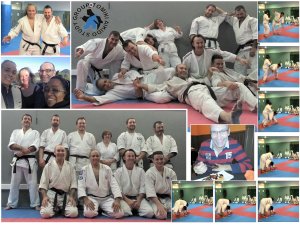 |
STUDY GROUP REPORT Sunday 2nd February 2014 – by Vicente Bosch
We started the last day's session by performing some light warm up to reduce the impact of Saturday Night. The third session was dedicated to the third standing section of Koryu Dai
Ichi.
|
Standing 3
1 Tenchi-nage
2 Tekubi-nage
3 Sukashi-nage
4 Shiho-nage
5 Sukui-nage
6 Kokyu-nage
1 Tenchi-nage - Both Uke and tori are in right posture; the technique starts with Uke grabbing both of Tori's wrists. Tori must make a connection with Uke if the technique is to work, for this purpose we played again with the connection game a bit more. Tenchi-nage actually means heaven and earth throw, thus we proceeded to first test the motion for the earth hand ( the left one ) going low as you step in with your left leg and lower your center of gravity, secondly we tried the solo motion of the heaven hand ( the right one) going high as a stretch that spirals from your stomach down to earth ( your legs) and upwards to your right hand, this creates a floating sensation. It is very important that you note that both heaven and earth hands are going neutrally up and down, Uke must not be pushed backwards otherwise he might step backwards if he is skilled. Once this stretch happens as the left leg goes in, the right one goes in between and the stretch relaxes. You can perform this technique at several levels, if you are starting and the grasp is very strong then it will be adequate to first step backwards ( unskoku undo ) before going forward (creating space between Uke and Tori) but if Uke is skilled he will mirror the movement hence the advanced way to do this is to make space my making your stomach go back before the forward step , thus doing this in an internal manner.
2 Tekubi-nage - Both Tori and Uke start with a left posture as Uke gets a hold of Tori's hands by his wrists. Again with this technique it is important to make a connection before the hand circular motion starts. The motion goes backward circling up to stretching Uke continuing the circle up to the projection point. The circling motion at a basic level can be performed with Unsoku movement but if Uke has skill he might mirror you, at an advanced level it is important to perform this circling motion with internal movement. Apart from varying skill degrees of movement from Tori we can ask for more from Uke, from a big projection in the direction of the left foot, to a shorter projection, to actually grabbing Uke and throwing him down or even changing the projection direction to Uke's back.
3 Sukashi-nage - This technique starts with both Tori and Uke walking to each other. Uke tries to get a grasp of Tori's wrists but as this happens Tori drops down on his right knee forcing Uke: who comes in with inertia, to roll over Tori. To make this work there needs to be a strong connection between Uke and Tori as they walk up to each otherwise it looks silly as Tori goes down on one knee and Uke just looks down due to his real lack of intention. The technique can be made more real by Tori actually swivelling their right back leg into Uke's legs as they drop down actually encouraging Uke to roll over.
Size Does Matter!
The sequence in the picture shows petite Anne attempting to perform a forward breakfall over generously proportioned Vicente.
4 Shiho-nage - The technique starts with Tori in left posture as Uke walks to grab both his wrists. Tori makes space between himself and Uke and grabs Uke's left wrist with his left hand, it must be made in a simple movement similar to clapping your hands. Tori steps inside Uke's centre with a left step ( the technique is Omote ) turns performing a Gasho movement ( stretching Uke all the way) and projects Uke.
5 Sukui-nage - is a technique that is part of many Koryu no katas. In this case for Dai Ichi it resembles the form seen in Dai Yon. Technique starts with Uke walking upto Tori to perform ryoti
dori, it is important to make a connection with Uke as he walks up to you and that Uke performs the grab with intention as Tori needs to use this action for the projection. An easy way to obtain this is for Tori to walk backwards a bit as Uke tries to reach him forcing Uke to make a committed grab. Once the grab and the connection is made Tori must go down in one knee as he uses his weight and a two handed spiraling movement from our basic exercises to get Uke over him. In the film with Ohba Sensei and Takeshi Inoue Sensei, Ohba sensei goes down on his left knee while projecting Inoue Sensei over his right side....
6 Kokyu-nage - This is also known as breathe throw. Tori temporarily offers their back to Uke in order to promote an attack.
Uke is in a strong position once the wrists are grasped. Tori drops back in order to establish a better or stronger stance. Tori stretches forward on exhale of breath as Uke is thrown into a forward Ukemi.
Tori maintains a streamline forward posture with the head inline with the arms.
We finished the session with the students performing the full kata. The attendants were divided in pairs and each of them performed an individual section of the kata thus forcing them to actually remember and reproduce the sequence and choreography of the kata, which was the objective of the seminar.
|
|
More Study Group Tomiki Aikido Sessions . . . . .
14th - 16th February, 2014 With guests from Spain in Antwerp, BELGIUM
22nd - 23rd March, 2014 Antwerp, BELGIUM
19th - 20th April, 2014 4th ETAN European Club Championship, Antwerp, BELGIUM
3rd - 4th May, 2014 Antwerp, BELGIUM
13th - 14th June, 2014 With guests from Spain in Antwerp, BELGIUM
|
|


